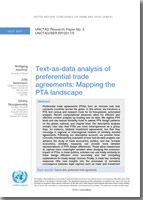
Preferential trade agreements (PTAs) have proliferated globally since the 1990s and now form a complex network of agreements connecting virtually every country in the world (Pauwelyn and Alschner 2015).
While their count can diverge depending on the definition that is used, the World Trade Organization's (WTO) repository of regional trade agreements (RTAs) notified to the WTO lists 291 PTAs in force, which can be considered a conservative lower bound.
Many of these PTAs are hundreds of pages long and contain an intricate web of detailed obligations. Due to its growing size and complexity, the PTA universe has become increasingly hard to navigate for scholars, policy-makers, negotiators, and litigators.
At the same time, the need for understanding PTAs to better assess their impact, importance, and evolution has never been greater with continued deadlock in WTO Doha Round negotiations and the emergence of new mega-regional deals such as the Comprehensive Economic and Trade Agreement (CETA) between the European Union and Canada and the on-going negotiations of a Tripartite Free Trade Area in Africa or of the Regional Comprehensive Economic Partnership (RCEP) in South East Asia.
In this article, we introduce a new structured corpus of digitized PTA full texts drawn from the WTO RTA database, and apply text-as-data tools to map the design of PTAs.
We argue that textual similarity measures are particularly suitable to capture fine-grained treaty design differences and find that the term PTA regroups a set of very heterogeneous agreements, which vary systematically in scope, content and language. Moreover, in contrast to bilateral investment treaties (BITs), which largely follow the design of country-specific model agreements of developed countries, PTAs cluster in regional or inter-regional groups of similarly worded agreements.
These agreements furthermore display a greater degree of customization amidst standardization than BITs. Finally, even PTAs that are similar in overall design typically display important textual variation in specific chapters.
In addition to providing a descriptive account of the design variation of PTAs, this article illustrates how similarity measures can be harnessed for specific disciplinary research applications.
In trade economics, textual similarity can complement existing measures of depth to capture more of the meaningful variation of treaty design when estimating the impact of PTAs on trade flows, as we highlight for the Trans-Pacific Partnership (TPP) Agreement after the withdrawal of the United States of America.
In trade politics, textual similarity metrics can help trace the diffusion of treaty design, which we exemplify by tracking the diffusion of NAFTA throughout the Pacific Rim.
Finally, in trade law, textual similarity can shed new light on normative convergence processes. Investment chapters in PTAs, for instance, are usually perceived to be contributing to the convergence of trade and investment law, but, as our analysis shows, potentially also fragment the two fields.



